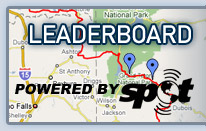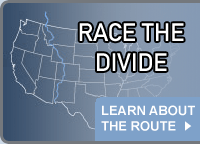June 5th 1988: The Day the Strong Men Cried
Below is a great account of the Gavia Pass stage of the 1988 Giro `d Italia by stage + GC (overall) winner, Andy Hampsten. His performance on the Gavia that day might be one of the greatest ever by an American in any European Grand Tour. Andy was a humble, North Dakota everyman capable of suffering to depths few could. His account describes weather reminiscent of the early days of `08 Divide Racing. Andy was Divide Racing material, to be sure.
By Andy Hampsten
From the start of the Giro, I knew the Gavia Pass was going to be the key stage. The 1966 winner of the Giro, Italian Gianni Motta had befriended our team and throughout the early stages of the Giro he kept telling me "Andy, the Gavia is your stage to take the pink jersey". It was really cool that an Italian was so supportive of an American and an American team trying to win his national race.
We knew that the conditions were going to be pretty bad on the Gavia Pass. The morning of the stage, the race director held a meeting with all the team managers and he told them that it was snowing on top of the pass but the road was clear. Armed with that information, our support personnel scoured the shops in Sondrio, where we were staying and bought all the warm gloves and wool hats they could find. Each rider was then asked to pack a special mussette bag which was to be handed to the rider 1/2mi before the summit of the pass. All our warmest clothes including the hats and gloves went into the bag.
The stage had two climbs, the relatively minor Passo Aprica, a 2000 foot climb followed by a 1500 foot descent then a long, gradual 2000 foot ascent up a valley to the 4500 foot, 10 mile climb over the Gavia Pass (8599 ft above sea level) followed by a 15 mile, 4500 foot descent into Bormio and the stage finish.
Things started to look grim on the descent of the Aprica. I was wearing tons of clothes, but the rain had been coming down in buckets from the start of the stage and I was shaking badly from the wet and cold. In the valley going up to the base of the Gavia I was upset because this was going to be my big day and it appeared that it was not going to happen. Slowly, I began to accept that it was going to be bad and that it was going to be bad for everyone else. I convinced myself that I should just stick to the plan that we had hatched weeks before. I had a good relationship with my coach, Mike Neel, and I trusted him. In 1985, my first Giro, he and I had driven the route of my first stage win in the morning before the stage started. Mike had shown me the exact spot to make my attack and I went on to win the stage.
I realized that I had to go 100% on the attack and hold nothing back. I had about 10 kilos of wet clothing from the weather, but I had to get rid of everything. I dumped my leg warmers and 2 extra jerseys. I was down to shoes and socks, shorts, 1 undershirt, a thin ong-sleeve polypro top and clear Oakleys. I was wearing the "performance" jersey which is the rider with the best combined point totals in sprints, climbing and overall classification made of pretty thick wool, which was nice! My biggest asset was that I kept my neoprene gloves. I realized that I had to keep my hands warm or I couldn't function.
Going up the valley, the "boys" (i.e. my teammates) were doing everything they possibly could for me; bringing me hot tea every 5 minutes; taking my clothes, etc. I was not sure how much I would have to suffer, but I felt that we were all going to have to go to a new limit to get over the pass. I knew I could suffer, but I also knew it would be very hard for my teammates so I was trying to psyche them up as well. I remember telling Bob Roll that this would probably be the hardest day on the bike in our lives.
At the bottom of the climb, the Del Tongo team was at the front riding tempo for their race leader, Chioccioli, but, everybody knew I was going to attack. When the road steepened, I went to the front and all the climbers marked my wheel. I could hear them muttering "Hampsten is going to attack" and trying to discourage me. At this point the road was still paved, but when I came around a left-hand switchback and saw the road turn to dirt and the 16% sign, I punched it. I was definitely playing head games. I wanted the other riders to be afraid of both my strength and of the height of the climb. The other riders knew I was strong, I had won the mountain stage to Selvino two days before. I was putting my cards on the table now, so early on the climb, because on the valley approaching the Gavia, I had re-affirmed my commitment to attack on this day.
I was prepared to attack multiple times, but I was relieved to see it break up so quickly into little groups. Zimmermann, Breukink, Chioccioli and Delgado were all chasing, but it was definitely breaking up. There was a small breakaway of minor riders up the road that was coming apart so I concentrated on picking off those riders. I was glad to finally be going hard again because I was still cold from the descent off the Aprica some 10 miles back.
Because of all the rain, the dirt was really shaky. It was pretty soft, each tire left a groove mark. I had to use my 39x25 to make progress. I think I was more comfortable on the dirt than everyone else; I trained a lot on dirt in Colorado and I had ridden a lot in the snow in Colorado and in winters in North Dakota, I had ridden my bike 3 miles each way to school in the snow.
As I climbed higher and higher, my mind started wandering and the psychological aspects of what was happening started to creep into my mind. I felt that I had achieved my results, to date, without taking any shortcuts, but when it started getting bad, I thought about what I could do to make things better. I gave up on asking God for any help, I was blessed already having the privilege of racing, instead I speculated on what I would bargain for if the devil showed up. Demoralized by this chain of thought, I realized that at the beginning of the day, I had relied only on myself to get me through the stage. On the Gavia, as always, there where no shortcuts and I had never looked for help from pills or other aids, although I was in such a mental state that I doubt I would have resisted any temptation that delivered me to Bormio. I must rely on myself to see me through.
At 4mi to go to the summit, my mind started going into a fog. I was going hard, but it was not like I was murdering anyone, Breukink was the closest behind at about 1 minute back. I started thinking about how cold I was now and the 15mi descent from the summit and the doubts started creeping in..... were the team cars going to get through? Would the soigneur be there at 2.5 mi to go with hot tea? Would Och be there at 1km to go with my bag? What would I do when I got my bag? I realized that if I stopped to put something on, I probably wouldn't keep going, so I decided to just take the bag and keep riding.
About 3mi from the top, I went to put on a wool hat but decided first to brush the water out of my hair, but my hand went 'thunk' on a huge snowball that fell onto my back.
I got a bottle of hot tea from our soigneur ET at the point of the climb that was carved out of the ountain-side, which is about 2.5 miles below the summit. I tried to hug the mountainside and get a moment of shelter but the spectators where more determined to shelter themselves than move. At 1mi to go, the wind picked up and the snow was blowing hard into my face.
I was creating tracks in the snow from my tires, but the traction was OK. Now I really started thinking about the 15mi of descending and how cold I was and how much colder I could get.
At 1/2mi to go, I took my special bag with a jacket and gloves from Och. The wind was blowing so hard that I could barely keep the bike going and put my jacket on, no-hands. In retrospect, I should have just stopped and put the jacket on since I lost 40-50 seconds to Breukink and he eventually caught me at the top, but if I had stopped, I may never have started again!
When I saw the buildings I thought that was the top of the climb (it was!) and if I was going to stop, I should do so here. But I really wanted to race at that point. It wasn't survival yet.
By the way it was snowing and the way the flakes were coming down, I figured the storm was coming from the north so I reckoned that the conditions would be much worse on the descent. Because of this, I didn't fly over the top but held back to save some energy for the descent.
When Breukink caught me at the top, at first, I thought I would follow him on the descent but he was going so slowly when the descent started that I figured I should go in front and make my own mistakes. I learned later that Breukink never put on a jacket. Instead, his team manager, Peter Post followed him down the descent and kept him alert by yelling and cursing at him.
I only had one gear for the descent, all the others had iced up and I kept thinking that I must keep pedaling to keep that one gear free of ice. The road at the top of the descent was gravel. It was better for descending than asphalt as it did not ice up. I tested it a couple of times to see if it was solid and it was. The spectators on the descent did not know if the race had been cancelled so they were wandering all over the road. On one turn, I almost hit a Carerra team mechanic holding a spare pair of wheels and walking down the middle of the road. I remember he was wearing this beautiful gore-tex full body suit and I really wanted to have it on me!
As I descended, I got colder and colder. I tried to shut out the cold and concentrate on the road ahead. It was asphalt now, but luckily it was not icy. I tried not to break too hard. When I used the brakes, first I had to break the ice from the rims, then scrape the water off before I got any stopping power.
I was concerned about hypothermia and just how much colder I could get before I was no longer able to pedal the bike. My arms were basically locked up from the start of the descent, I just tried to keep pedaling to keep my legs moving. At one point, I looked down at my legs and through a layer of ice and lanolin grease, I could see that they were bright red. After that, I didn't look at my legs again.
About 10km into the descent, Mike Neel in the team car caught up with me. There wasn't much he could do, the snow had turned to a cold rain, all I cared about was getting down to a place which was warm and I could stop.
At about 6km to go, Breukink caught me, but I was totally blocked and could not respond. Breukink had no rain jacket on, just a jersey, so he could descend faster on the long straight drop into Bormio. There was no bloody way I was going to take my jacket off.
After I crossed the finish line, I headed straight for our our soigneur, Julie. I was in such a rage trying to get down the mountain in one piece that when our team doctor, Max Testa, came up behind me and tried to put his jacket around me, I didn't realize who it was and since he was keeping me from Julie and my warm clothes, I started punching him. Mike Neel came over and straightened me out and got me in the team car, which was running it's heater full blast! When I started to warm up the pain started to come back. Mike then told me I had the jersey and the pain and the euphoria swept over me and I just started crying, laughing and shaking. A whole wave of emotions covering the rage to finish the stage to the realization that I would survive me a brief and refreshing emotional meltdown.
Within 10 minutes of the finish, I was up on the podium. The pink jersey felt good. I slipped it on and all my doubts went away. The TV interviews began and I remember saying "Incredible, I have never seen conditions like this, even in Colorado. Today it was not sport, it was something beyond sport."
Everyone who made it over the Gavia that day was a winner. Even to this day, there is a clique of riders whose bond is that they rode over the Gavia that day.
On this unforgettable day, which La Gazzetta dello Sport dubbed "The day the big men cried," conditions were so extreme, and time gaps so massive, that organizers did away with the time limit and allowed all who finished to remain classified.






